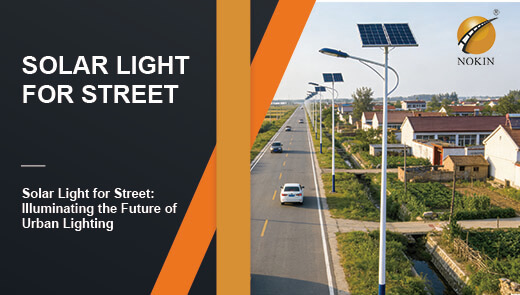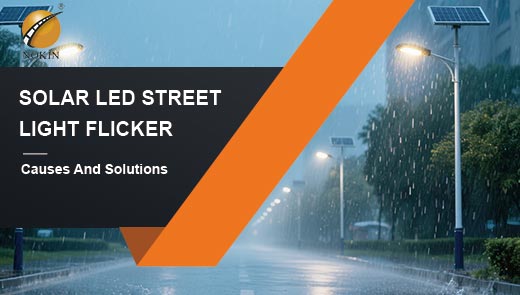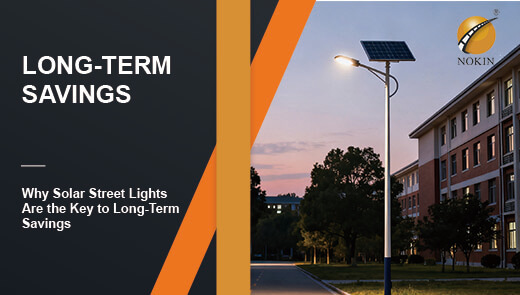Solar Street Light Battery Replacement
Solar street lights, with their advantages of "zero electricity cost and no pollution", have been widely applied in municipal roads, community courtyards, rural roads, parks and scenic spots, etc. But many people do not know that the core lifespan of seemingly "maintenance-free" solar street lights actually depends on a key component - the energy storage battery.
As the usage time increases, the battery will gradually fail due to factors such as "cyclic charging and discharging" and "environmental aging" : a solar street light that could originally stay on for 8 hours may go out in just 3 hours. Once bright lights will become dim and indistinct, and may even completely fail. At this point, whether the battery is replaced in time and whether the right battery can be selected directly affect the performance of solar street lights and even determine whether additional funds are needed to replace the entire set of street lights. Next, NOKIN will provide you with a detailed breakdown of the entire process for replacing solar street light batteries, helping you avoid pitfalls and restore the luster of your old solar street lights.
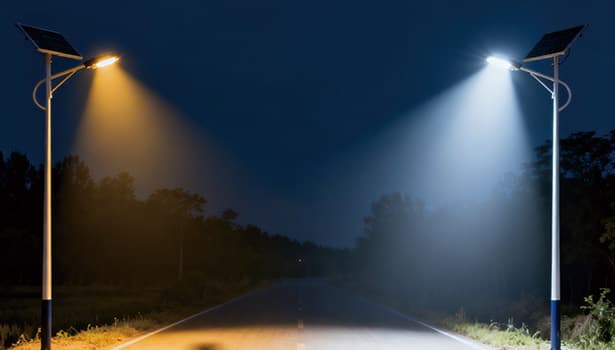
3 Signs that Solar Street Light Batteries Need to Be Replaced
The Lights Dimmed Significantly
Under normal circumstances, the brightness of solar street lights remains stable and can clearly illuminate the preset range. If you notice that the light of a solar street light becomes significantly dim or even shows "local black shadows", it might be a sign of battery aging.
This kind of "darkening" is not an accidental phenomenon but a long-term and continuous change: for instance, pedestrians who were originally clearly visible 10 meters away now become blurry 5 meters away. Or there are multiple sets of street lights in the same area, and one of them is significantly dimmer than the others. The reason is quite simple: The capacity of an aging battery decreases, and the stored electrical energy is insufficient. When discharging, it cannot provide a stable rated voltage for the LED beads, resulting in a reduction in brightness.
The Battery Life Has Shortened
When each set of solar street lights is installed, the night operation duration is set according to the local sunlight conditions: for example, street lights on municipal roads are usually set to be on for 8 to 10 hours (from evening to the early morning of the next day), and those in residential areas are set to be on for 6 to 8 hours (from dark to 12 o 'clock at night). If you find that the street lights frequently turn off prematurely, it indicates that the battery can no longer meet the power supply requirements.
The core reason behind this is that the "cycle life" of the battery has approached its upper limit. The cycle life of a common lead-acid battery is approximately 300 to 500 times, while that of a lithium iron phosphate (LiFePO4) battery is about 2,000 to 3,000 times. Once the cycle count reaches the standard, the "charge and discharge efficiency" of the battery will drop from over 80% to below 50%, with a significant decline in power storage capacity. Naturally, it cannot support the preset battery life of solar street lights.
The Solar Street Light Suddenly Stopped Working
If a solar street light suddenly stops lighting up completely and the faults of the solar panel and the controller are ruled out, it is very likely that the battery has "completely failed" and is unable to store electricity. In such cases, it is recommended to conduct a two-step investigation first to avoid misjudgment:
Inspect the solar panels: Check if there are any obstructions on the surface of the solar panels, if there are any damages or cracks, and if the wiring is loose. If the solar panels are functioning properly, you can measure their output voltage with a multimeter (at noon on a sunny day, the voltage of the solar panels for a 12V system should be between 18 and 22V) to confirm whether they can generate electricity normally.
Check the controller: Verify if the indicator light of the controller is functioning properly. If the indicator light does not light up or flashes abnormally, you can try restarting the controller or replacing it with a controller of the same model for testing.
If there are no issues with the solar panels or the controller but the street lights still do not light up, it can basically be determined that the battery has failed. At this point, the battery may have suffered physical damage such as "swelling" and "leakage", or even internal electrodes may break, completely losing its power storage capacity. It must be replaced immediately.
3 Benefits of Solar Street Light Batteries Replacement In Time
Many people think that "as long as the street lights can light up, there's no need to replace the batteries", but in fact, delaying the replacement not only affects the lighting effect but may also increase the subsequent maintenance costs. Timely replacement with a high-quality battery that is compatible can actually bring three core benefits.
Ensure the Solar Street Lights Lighting Performance
The charge and discharge efficiency of the new battery can reach over 85%, which can provide a stable rated voltage for LED beads and avoid the "flickering" caused by voltage fluctuations.
In addition, the new battery can also prevent the risk of LED beads being damaged by low voltage. When the voltage of the old battery is too low, the LED beads will experience "flickering" due to insufficient power supply. Over time, this will accelerate the aging of the beads and shorten the lifespan of the lights. After replacing the battery with a new one, the voltage stabilizes, which can indirectly extend the service life of the LED beads.
Upgrade The Solar Street Lights Energy Efficiency
The anti-weak light ability of solar street lights largely depends on the battery's energy storage efficiency. After the power storage efficiency of old batteries declines, even if solar panels can generate electricity, they cannot effectively store electrical energy, resulting in "not enough on sunny days and insufficient on cloudy days".
The new batteries have a higher power storage efficiency, especially lithium iron phosphate batteries, which can efficiently receive electricity from solar panels even in weak light conditions (such as cloudy days, early mornings, and evenings). This means that the new battery can make solar street lights more durable, reduce their reliance on sunny days, and adapt to more climatic conditions, especially suitable for the rainy and foggy southern regions or the northern regions with short winter sunshine.
Reduce the Long-term Cost of Solar Street Lights
The greatest advantage of replacing the battery is that it can significantly reduce the cost of equipment replacement. The price of a complete set of solar street lights is usually high, while the cost of replacing a separate set of batteries will be significantly reduced. More importantly, replacing the battery does not require removing the light post or rewiring. The installation time is only 1 to 2 hours per set (removing the old battery and installing the new one), while replacing the entire set of street lights takes 4 to 6 hours per set and may also affect road traffic. From the perspectives of time cost and labor cost, replacing the battery is also a better choice.
How to Choose Solar Street Light Batteries?
Lock the "deep cycle" battery and reject the "start battery"
Solar street lights require "deep-cycle batteries" rather than the "starting batteries" used in cars and motorcycles. The core difference between the two lies in the "discharge method".
Deep-cycle battery: It can withstand "deep discharge" (with a discharge depth of up to 80% or even 100%), and can be repeatedly charged and discharged multiple times, making it suitable for the cycle scenario of "charging during the day and discharging at night" in solar street lights.
Starting battery: Designed to "instantly release a large current" (for starting the engine), it cannot withstand deep discharge. If used in solar street lights, it may fail within 1-2 months.
At present, the deep-cycle batteries suitable for solar street lights on the market are mainly divided into two categories: lithium iron phosphate (LiFePO4) batteries and deep-cycle lead-acid batteries (including gel lead-acid and sealed lead-acid). For a detailed comparison of the two, please refer to the table below:
|
Comparison Item |
Lithium Iron Phosphate (LiFePO4) Battery |
Deep-Cycle Lead-Acid Battery |
|
Cycle Life |
2,000–3,000 cycles (about 5–8 years) |
300–500 cycles (about 2–3 years) |
|
Weight |
Light (about 1/3 the weight of lead-acid at the same capacity) |
Heavy (requires 2–3 people for handling) |
|
Energy Density |
High (large energy storage, compact size) |
Low (small energy storage, bulky size) |
|
Maintenance Requirements |
Maintenance-free (sealed design) |
Requires regular maintenance (gel type doesn’t need water, sealed type needs leak inspection) |
|
Temperature Adaptability |
Excellent (-30℃ to 60℃) |
Average (-10℃ to 50℃), poor low-temperature performance |
|
Initial Cost |
High (about 2–3 times the cost of lead-acid) |
Low (cost-effective) |
|
Safety Performance |
High (no risk of explosion or leakage) |
Medium (may bulge or leak) |
|
Applicable Scenarios |
Municipal roads, high-end residential areas, rural roads in cold regions |
Temporary sites, and scenarios with limited budgets |

The Capacity Matches the Energy Consumption Demand of Street Lights
The unit of battery capacity is "ampere-hour (Ah)", which represents the battery's power storage capacity: 1Ah=1 ampere of current for continuous discharge for 1 hour. For instance, for a 12V/20Ah battery, the total storage capacity is 12V×20Ah=240Wh (watt-hours).
When choosing capacity, it is necessary to calculate based on the "power" and "preset endurance time" of the street light. The formula is as follows:
Battery capacity (Ah) ≥ (street light power W × battery life h) ÷ Battery voltage V ÷ discharge efficiency
Among them, the discharge efficiency is calculated at 80% (the average discharge efficiency of deep-cycle batteries). Here are two practical cases:
Case 1:12V/10W street light, with a preset battery life of 8 hours
The battery capacity is ≥ (10W×8h) ÷12V÷0.8≈8.33Ah. Therefore, it is sufficient to choose a 12V/10Ah or 12V/12Ah battery.
Case 2:24V/30W street light, preset battery life of 10 hours
The battery capacity is ≥ (30W×10h) ÷24V÷0.8≈15.625Ah. Therefore, it is more reliable to choose a 24V/20Ah battery.
It should be noted that a larger battery capacity is not always better. If the capacity is too large, it will cause the solar panel to "fail to be fully charged" (for example, a 12V/100Ah battery requires a solar panel with a higher power to be fully charged within a day), which will instead result in a waste of resources. If the capacity is too small, it will not meet the battery life requirements and the street light will go out prematurely.
The Voltage Strictly Corresponds to the Solar Street Light System
Solar street light systems are divided into "12V systems" and "24V systems" (a few high-power street lights are 48V systems). The battery voltage must be exactly the same as the system voltage; otherwise, the controller and LED beads will be damaged.
The harm of voltage mismatch is extremely serious: for instance, connecting a 24V battery to a 12V system can cause the controller and LED beads to burn out due to "overvoltage", directly leading to equipment damage. When a 12V battery is connected to a 24V system, if the battery voltage is insufficient, the street light will have low brightness and short battery life. Moreover, due to "under-voltage", the controller will frequently protect itself and fail to work normally.
Therefore, before choosing a battery, it is essential to first confirm the voltage of the original system: you can check the label on the controller (usually marked as "12V/24V"), or check the voltage parameters of the old battery (for example, if the old battery is marked as "12V", it is a 12V system).
Adapt to the Local Climate and Temperature
The climate varies greatly among different regions, and the "temperature adaptability" of batteries directly determines their service life. If ordinary lead-acid batteries are used in the severely cold northern regions, they may fail to discharge in winter due to "freezing of the electrolyte". Using low-quality lithium batteries in high-temperature southern regions may lead to failure due to "high-temperature bulging".
Battery selection recommendations for different climate zones are as follows:
|
Climate Zone Type |
Temperature Range |
Recommended Battery Type |
Selection Precautions |
|
Extremely Cold Regions |
-30℃ to 20℃ |
Low-temperature LiFePO4 batteries (marked “low-temperature start at -30℃”) |
Avoid using lead-acid batteries, as their capacity drops by more than 50% at low temperatures |
|
High-Temperature Regions |
10℃ to 60℃ |
LiFePO4 / Gel lead-acid batteries with high-temperature-resistant casings |
Avoid direct sunlight on the battery box and regularly check the battery temperature |
|
Humid and Rainy Areas |
5℃ to 35℃ (high humidity) |
Sealed LiFePO4 / Gel lead-acid batteries |
Ensure waterproof battery box design to prevent rainwater entry and short circuits; protect lead-acid batteries from leakage and corrosion |
|
Temperate and Humid Zones |
-5℃ to 30℃ |
LiFePO4 / Ordinary lead-acid batteries |
No special requirements; select conventional models and regularly clean dust inside the battery box |
Refuse Cheap and Inferior Batteries
The prices of batteries on the market vary greatly. Many people choose "cheap batteries", but these batteries often have three major problems:
|
Problem Type |
Specific Manifestations |
Possible Consequences |
|
False Capacity Label |
Labeled as “12V/20Ah,” but the actual capacity may only be 12V/10Ah |
Significant reduction in battery life and poor user experience |
|
Short Lifespan |
Cycle life is only 100–200 times; becomes ineffective after about one year |
Requires frequent replacement, increasing maintenance costs |
|
Safety Hazards |
Risks of “leakage,” “bulging,” or “explosion,” especially during hot summer |
May cause safety accidents, equipment damage, or personnel injury |
Therefore, when choosing batteries, it is essential to "prioritize quality over price". It is recommended to make judgments from three aspects:
Choose reputable brands:
Give priority to well-known brands and avoid purchasing "unbranded, unmodel-free", "three-no" products.
Check the quality inspection report:
Ask the supplier to provide the battery's "3C certification" and "quality inspection report" to confirm that the battery meets safety standards.
Inquire about after-sales service:
Choose batteries that offer a "one-year or longer warranty". If any problems occur during use, they can be replaced promptly through after-sales service to reduce risks.
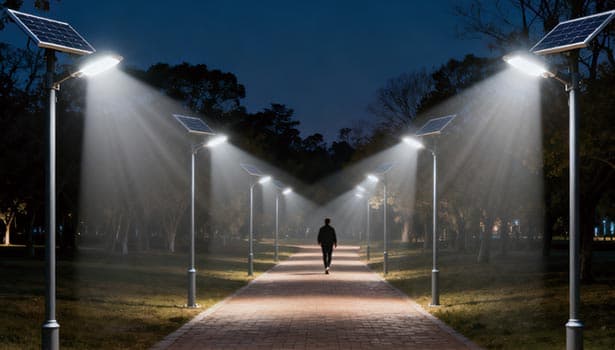
Frequently Asked Questions (FAQ)
Q1: How long can the battery of a solar street light last?
The lifespan of lithium iron phosphate batteries is approximately 5 to 8 years, while that of deep-cycle lead-acid batteries is about 2 to 3 years, depending on the frequency of use, climatic conditions, and maintenance.
Q2: When replacing batteries, can lead-acid batteries be replaced with lithium iron phosphate batteries?
A2: Yes, but it's necessary to confirm whether the controller supports the lithium iron phosphate mode. If the controller only has lead-acid mode, it needs to be replaced with a dual-mode controller to avoid overcharging and overdischarging.
Q3: Can a swollen battery still be used?
A3: No. Battery swelling is caused by the decomposition of the internal electrolyte and the expansion of gas. Continuing to use it may lead to leakage and explosion risks, and it needs to be replaced immediately.
Q4: Is the short battery life of solar street lights in winter due to battery issues?
A4: It might be due to poor low-temperature performance of the battery, or it could be because of the short duration of sunlight in winter. It is recommended to replace the low-temperature resistant lithium iron phosphate battery and adjust the battery life at the same time to avoid the battery being completely drained.

